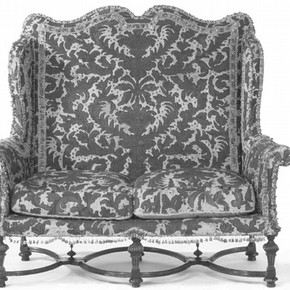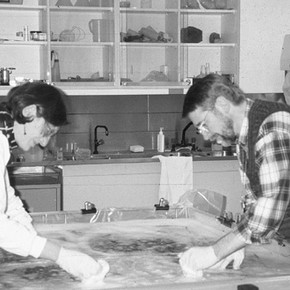Conservation Journal
October 1999 Issue 33
Don't Sit Down! The Investigation and Conservation of an Upholstered Seventeenth Century Settee
Introduction

Figure 1. Hampton Court House settee (W.15-1945) before conservation (click image for larger version)
The settee,( Museum No. W.15 1945), shown in Figure 1, will form part of a display which will emphasise upholstery, in the Tudor and Stuart section of the new British Galleries. It is an interesting example of late seventeenth century seat furniture because of its overall design and its covers. It retains its original under-upholstery, canvas-work embroidery top covers, silk and linen trimmings and stamped yellow wool outside covers.
The settee was part of the contents of Hampton Court House, a mansion outside Leominster, Herefordshire auctioned on March 16th 1925. The settee did not come into the V&A until 1945. There is a note on Museum Registered Papers stating: 'December 1971. There are still about six tall back chairs of this design at Hampton Court (House).' Unfortunately it is not known whether they retained their canvas work covers at that time and have subsequently been dispersed.
Examination and Condition of the Settee
The settee has a high back, scroll arms, wings and two cushions. Its inside covers are wool and silk canvas work embroidery in shades of dark red, brown and cream with the foliate design outlined in black. The outside back, wings and arms are covered in yellow wool with a meandering design stamped into it. This wool fabric, harrateen, is also used on the bottom of the cushions and their unseen borders and other areas that are mostly not visible. The settee is trimmed with a wide cream and blue braid woven in linen and silk and a similarly-coloured bell fringe.
When the settee was first inspected in one of the furniture stores as part of the British Galleries conservation survey, there was doubt about the authenticity of the upholstery for various reasons. The trimming was blue and cream but there was no blue in the canvas-work and there were sections that lacked trimming for no obvious, logical reason. The position on the arms, where the inside and outside covers joined together, looked rather strange. The motif on the cushions appeared to be upside down. Why were the outside covers yellow when there was no yellow in the canvas-work?
To resolve these questions the settee came into the Textile Conservation Studio for investigation. The whole object was inspected and parts of the cover lifted to reveal some of the under-upholstery. By looking at tacks and tack holes and their positions in relation to the various layers of materials, and also at stitching threads and repairs, it was possible to deduce that although there had been some repairs and minor alterations, the upholstery was all original, making this an important object to include in the British Galleries.
During the investigation, areas of fabric that had been long hidden were revealed, showing some of the original striking, almost garish, colours. The inside covers were originally worked in bright red and dark red wool with the design outlined in black. The 'cream' silk had in fact been a bright yellow, which explains why the stamped yellow wool fabric was used on the outsides. This too was originally bright yellow and quite large areas remain which have not been exposed to light and pollution.
Although the blue of the trimming is now mostly pale and drab, parts of it were once bright with some dark areas to contrast with the pale cream sections. The covers of the arms and wings are made up of several sections of the canvas work embroidery, not all running in the right direction. This could indicate that the covers were not worked especially for this piece but were cut and fitted by the upholstererfrom fabric supplied by the client.
Blue linen thread has been used (double) throughout for the making up of cushions and stitching of the trimming. Hand-made iron upholstery tacks have been used to attach the covers and fringe to the frame. Although the tacks are dark, they remain fairly visible. This seems rather crude for a piece of upholstered furniture that must have been dazzling when new.
Although once glowing with colour, the settee's present condition gives little idea of its original appearance. As well as the fading of some colours, the wool and silk fibres have also absorbed dirt, possibly from coal fires, making them dark and drab. Some parts of the linen and silk in the wide blue and cream border have degraded, leaving the trimming looking threadbare. In other areas, such as the tops of the arms, the loss is much greater, leaving only the edge of the trimming to show that there was once trimming there.
The silk bell fringe is very degraded, especially around the bottom of the settee. Worn areas on the canvas-work embroidery have been re-embroidered: evidently this was done at different times and long after manufacture because the colours that were used match the faded colours rather then the original ones. The stamped yellow wool on the outsides is very dirty - black in places - and there are small holes due to insect damage.
Treatment
A treatment proposal was drawn up with the aim of improving, or at least stabilising, the condition of the settee and improving its overall appearance. The intention was to do this without removing too many of the original fixings (upholstery tacks and stitching threads). The treatment was discussed with Curators from the Furniture and Woodwork Department. We agreed the first steps and planned for further meetings as the work progressed.
Removing the canvas-work embroidery for cleaning was not an option because all the original tacking would have been lost. The dirt on the wool and silk embroidery was, in any case, not as obvious as it was on the yellow wool. While the fibres could have been made less acidic and brittle by cleaning, the appearance may not have been greatly improved. However, we considered that wet cleaning the yellow wool would remove much of the dirt improving both its condition and its appearance. The original tacking to the outside back cover had been lost when it had been removed to facilitate repairs to the frame some time in the past. A support fabric had also been inserted because of large losses in the wool due to insect damage.
Wet-cleaning the yellow wool would improve its condition but a number of questions were raised. Would it be so clean that it would make the canvas work embroidery look dark and dreary? How much would it shrink and was it strong enough to be tensioned out to its original dimensions? Would the stamped design be lost due to the swelling and relaxing of the fibres? It was agreed that the outside back cover should be washed first and the results evaluated.

Figure 2. D Balfour and D Trupin wet cleaning outside back cover. Photograph by Elizabeth-Anne Haldane (click image for larger version)
Deborah Trupin, a colleague from the New York Bureau of Historic Sites, in Textiles Conservation on an exchange programme1, helped with this part of the project (see Figure 2). Test-cleaning a small sample of the wool confirmed that the dye was fast and that the stamped decoration would not be harmed by the proposed cleaning process. The outside back cover was carefully removed from the frame and its surface cleaned by low-suction vacuuming. Old sections of support fabric that had been stuck to the wool as part of a much earlier conservation treatment were removed as was all the remaining adhesive, probably wheat starch paste as it swelled and softened in water.
A template was made of the cover, including the areas of loss, by drawing around it on Melinex® (polyester sheet). The fabric was then wet cleaned in de-ionised water with Synperonic N2 ® non-ionic detergent at room temperature. We used standard processes of soaking, rinsing, soaking and sponging to force the washing solution through the material. Several rinses in clean water followed until the water was clear and detergent-free.
Absorbent paper was used to remove excess water before pinning the fabric out face down over the template, on polyethylene-lined soft board. Melinex® had been laid on top of the template to isolate the marker ink from the fabric. It was then left overnight to dry completely. The wet cleaning was judged a success because the wool is soft and pliable again, the colour is much improved and the stamped design more visible.
Curators and conservators compared the newly-clean wool cover from the outside back with the covers remaining on the settee. The yellow wool on the outside covers of the arms and wings have faded much more than the outside back cover and it was agreed that these outside covers should be wet cleaned too. They are decorated with the blue and cream trimming and, if possible, the cleaning should proceed without removing the trimming.
In the meantime the canvas-work embroidery and accessible parts of the under-upholstery have been surface cleaned and non-visible parts of the insect damaged wool supported and protected by nylon net. The process of cleaning and correcting the orientation of the cushion panels is underway.
Conclusion
Whilst it would be preferential to complete a project such as this without interruption, discussions and planning for the rest of the British Galleries has to continue too. This means that the work is carried out over a longer period, but at least we have the advantage of allowing time to pause and consider - or reconsider - the object's treatment.
References
1. The exchange involved Deborah and the author working together for six weeks in each of their institutions, September-December 1998. Their thanks to the Getty Grant Program for financial support and to their respective institutions.
2. Synperonic N (nonyl phenol ethoxylate) will be phased our for industrial use from 2000. The Textile Conservation Section is in contact with other institutions to review and research alternative detergents. See also Daniels, V., Synperonic N and NDB, Paper Conservation News, March 1999
October 1999 Issue 33
- Editorial - Changing Landscapes
- The British Galleries 1500-1900: An Overview
- 'Method in our Madness': Method Statements and the British Galleries
- Removal and Installation of Mirrors for the British Galleries Project
- The Remounting of a Victorian Tile Panel
- A Brief History of Mounts
- Don't Sit Down! The Investigation and Conservation of an Upholstered Seventeenth Century Settee
- Off-site Radio Telemetry
- Science Surgery
- Printer Friendly Version